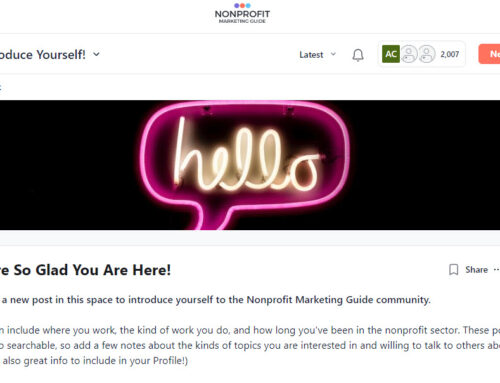
You are already working in nonprofit communications and marketing. How do you move up in your nonprofit marketing career? Below, we outline the nonprofit communications and marketing training plans we recommend here at Nonprofit Marketing Guide (NPMG).
The Beginner Training Plan
At the Beginner level, we recommend that you focus on implementing the following skills and actions:
- “Quick and dirty” marketing plans
- Getting away from marketing to everyone or the general public
- Using clear and specific calls to action
- A communications schedule where you reach everyone at least monthly
- Defining a consistent visual brand
- Basic copywriting, editing, and graphic design skills
You should focus next on learning about the following marketing concepts:
- Planning fundamentals, like using an editorial calendar
- Prioritizing your target audiences, how to build lists, and basic segmenting of your email list
- Developing consistent messaging and understanding how to make your messaging more relevant and engaging
- Integrating your communications channels and repurposing content
- The different styles of nonprofit writing
- Project management and personal productivity skills
The Intermediate Training Plan
At the Intermediate levels, we recommend that you focus on implementing the following skills and actions:
- The Big Picture Communications Timeline, an editorial calendar, and making time to think strategically and to adjust plans as needed
- Prioritizing your target audiences, building your lists, and segmenting your email list
- Creating relevant content and developing a content marketing strategy
- Integrating how you use all of your communications channels to build engagement and getting the most out of the content you create
- Creating a messaging platform and a “marketing bank” for other staff to use
- Successfully using several different writing and visual communications styles
- Building trust in your marketing skills and your project management skills
You should focus next on learning about the following marketing concepts:
- Creating integrated marketing plans and strategies
- More advanced understanding of your target audiences, how to segment communications, and managing your lists for engagement
- Developing core topics that you want to be known for as a thought leader
- Best practices for email engagement, website SEO, and advertising
- How to resolve conflicts, influence others, and be more strategic overall
- How to establish communications workflows and processes
- How to measure success
The Advanced Training Plan
At the Advanced levels, we recommend that you focus on implementing the following skills and actions:
- Fully integrating your communications planning with organizational goals, including crisis communications planning
- Systematically listening to your community and using personas or journeys to understand their relationships with your organization
- Sharing highly relevant and on-brand original and curated content on your core topics
- Producing more video and more sophisticated visual content
- Leading communications planning and setting expectations around boundaries and deadlines
- Simplifying and documenting communications workflows and processes
- Measuring success and optimizing your various approaches to content and channel management
We recommend that you next try to innovate and experiment here:
- Using project management software to integrate your editorial calendar and workflows
- Consistently making time for strategic conversations throughout the organization
- Running creative experiments with content and communications channels
- Using advanced list growth, segmenting, and engagement techniques
- Mastering the various writing styles
Another way to think about moving up is how you might move from a coordinator to a director role. In this previous post, we cover these three essential steps that will help you move up:
- Demonstrate that you can think strategically
- Take control of your own professional development
- Grow your way into management by growing your team
We hope this helps you make good choices as you develop your own nonprofit communications and marketing training plan.






